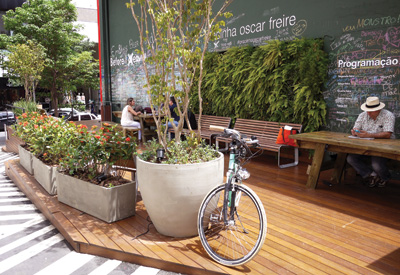
Photo: REUD Brazil
Evidence Based Strategies
- Site and design projects to maximize access to on- and off-site high-quality parks and recreation spaces.
- Create adaptable, multiuse spaces for community gathering, play, and social activity for all ages.
- Accommodate diverse uses (for example, dog parks, skate parks, and picnic facilities).
- Incorporate exercise equipment for all ages, such as outdoor elliptical machines and circuit training equipment.
Best Practice Strategies
- Develop on-site recreation spaces that suit the project scale, from a large neighborhood park to a parklet (which is a small, often temporary park).
- Ensure that routes leading to new and existing parks are safe, well marked, and well lit.
- Locate new parks and play spaces in view of busy sidewalks or streets, and incorporate appropriate lighting.
- Provide swimming pools, where appropriate.